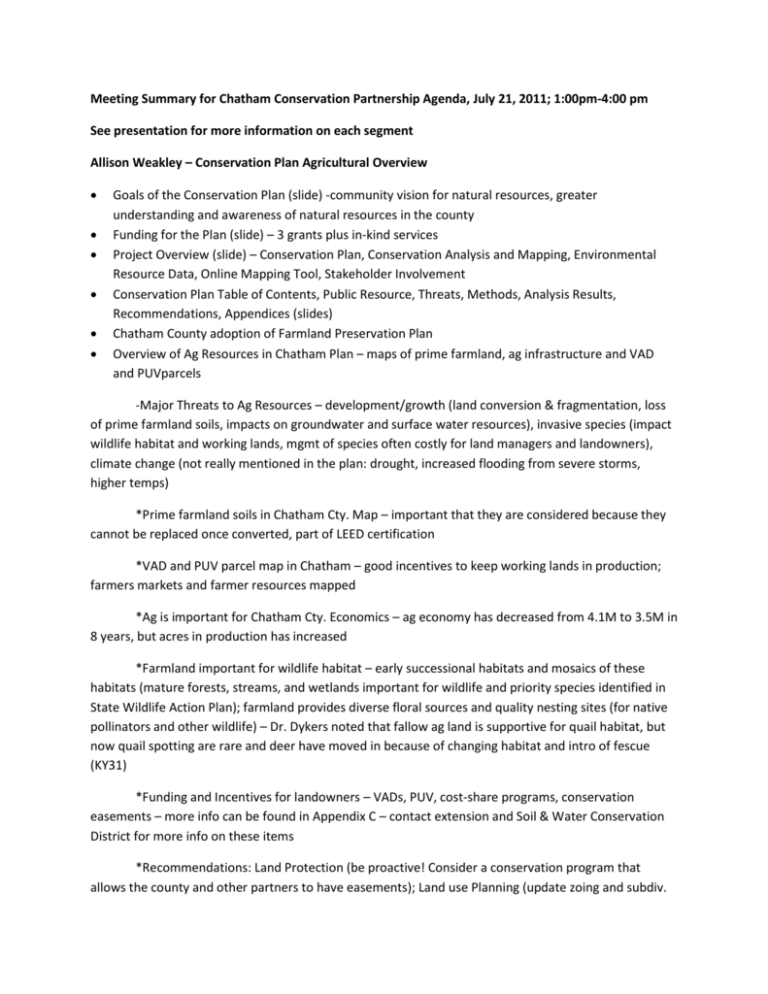CCP Meeting 7-21-11 Notes
advertisement

Meeting Summary for Chatham Conservation Partnership Agenda, July 21, 2011; 1:00pm-4:00 pm See presentation for more information on each segment Allison Weakley – Conservation Plan Agricultural Overview Goals of the Conservation Plan (slide) -community vision for natural resources, greater understanding and awareness of natural resources in the county Funding for the Plan (slide) – 3 grants plus in-kind services Project Overview (slide) – Conservation Plan, Conservation Analysis and Mapping, Environmental Resource Data, Online Mapping Tool, Stakeholder Involvement Conservation Plan Table of Contents, Public Resource, Threats, Methods, Analysis Results, Recommendations, Appendices (slides) Chatham County adoption of Farmland Preservation Plan Overview of Ag Resources in Chatham Plan – maps of prime farmland, ag infrastructure and VAD and PUVparcels -Major Threats to Ag Resources – development/growth (land conversion & fragmentation, loss of prime farmland soils, impacts on groundwater and surface water resources), invasive species (impact wildlife habitat and working lands, mgmt of species often costly for land managers and landowners), climate change (not really mentioned in the plan: drought, increased flooding from severe storms, higher temps) *Prime farmland soils in Chatham Cty. Map – important that they are considered because they cannot be replaced once converted, part of LEED certification *VAD and PUV parcel map in Chatham – good incentives to keep working lands in production; farmers markets and farmer resources mapped *Ag is important for Chatham Cty. Economics – ag economy has decreased from 4.1M to 3.5M in 8 years, but acres in production has increased *Farmland important for wildlife habitat – early successional habitats and mosaics of these habitats (mature forests, streams, and wetlands important for wildlife and priority species identified in State Wildlife Action Plan); farmland provides diverse floral sources and quality nesting sites (for native pollinators and other wildlife) – Dr. Dykers noted that fallow ag land is supportive for quail habitat, but now quail spotting are rare and deer have moved in because of changing habitat and intro of fescue (KY31) *Funding and Incentives for landowners – VADs, PUV, cost-share programs, conservation easements – more info can be found in Appendix C – contact extension and Soil & Water Conservation District for more info on these items *Recommendations: Land Protection (be proactive! Consider a conservation program that allows the county and other partners to have easements); Land use Planning (update zoing and subdiv. Regs to meet natural resource needs, consider conservation overlay districts, strengthen VAD program and consider EVAD, develop a strategic farmland map and plan, advocate for state policies that are supportive of ag, explore long-term access to water supplies, consider land use and mgmt in local, state and national levels; Resource Management – prevent introduction, promote BMPs on working lands, promote and encourage restoration of degraded habitats to benefit wildlife and water quality, consider NCWRC recommendations to manage for potential impacts to aquatic and terrestrial species; Coordination with Partners – with state and federal agencies, conservation orgs; Education, Outreach, and Stewardship – educate developers, government staff, elected officials, and landowners on importance of natural resources, programs, incentives, promote and provide technical assistance, enhance public understanding of importance of ag; Funding and Incentives – PUV, cost-share programs; Monitoring – status, trends, and conditions of important resources in the county (need periodic review once baseline established), develop process for GIS file sharing and updating, coordinate with resource agencies and other conservation partners so info can be considered in local planning; Implementation and Updates – keep GIS up to date, keep plan info up to date, continue to review, consider, and incorporate other current planning efforts locally, state wide and federal *Link to the wiki Question: why has ag land use grown, but GDP shrunk? -Sam Groce – county GDP took a major hit and greatly affected economics, cattle prices were low, increase in purchasing in land due to increase of vegetable production, traditional large income producers have shrunk -Debbie – 500% value increase in direct marketing produce -Sam – mentioned ethanol production – food vs. fuel – in Chatham can’t grow corn economically. Ethanol subsidies may be eliminated at Fed level Rich Hayes – The Soils of Chatham County CD copies of Soil Survey for Chatham County available at Chatham Soil & Water Conservation District Completed mapping in 2000, electronic versions available now, no longer book form *General soil map of county *Google earth map showing land use *Carolina Slate belt – largest of general soil map units – georgeville (RED!), badin (mostly Red), nanford (yellow) soil series (each series has different characteristics, depth to water, bedrock, chemical, physical) – runs Pittsboro to Siler City –these soils good for farmland AND for development because they perc/welldrained, low shrink/swell, large depth to bedrock – these areas had a lot of dairies because it’s good corn land; tallest trees in the county (good for row crops and forestry) -Goldston area – Cid-Nanford-Lignum series – very wet areas, shallow to bedrock – little row cropping, a lot of poultry and beef cattle – good soil for growing grass – doesn’t perc – area will be limited for development as long as wastewater treatment problem exists – lots will stay above 3-5 acres because single family septic sprayfield system requires that acreage -Callison-Lignum – callison has low clay content but high silt – very little row crops, but lots of poultry and beef – very wet, difficult for development, shorter trees -Nanford-Badin – shallow, but well-drained soils *Triassic Basic – Jordan Lake area – is a huge valley – very wet soils, very high in clay content, high shrink/swell, difficult to find perc soils, high in aluminum which limits types of plants, very low pH (legumes can’t grow), very little farming because pH so low and needs excessive amounts of lime to alter -Creedmoor-Green Level (GL is new soil discovered during survey – acts like concrete relating to water infiltration -Mayodan – form from sandstone and conglomerate, better permeability, a little bit of farming, some prime farmland soils here – red soil means it’s “rusty” so there is a lot of oxygen getting into the soil -Carbonton-Brickhaven – red color, not very well-drained, unique chemistry, but not considered hydric, no ag here, most acidic soils in county, native blueberries here *Chapel Hill Granite -Wedowee – well-drained, perc fairly well, not fertile soils but can be farmed if recommendations followed for fertilizer, saprolite (highly weathered granite) -Helena-Vance-Wedowee – magma intrusions, have drainage problems *Raleigh Belt Gneiss and Schist -Cecil Pacolet – very deep soils, red clay, contains saprolite (highly weathered rock) *Alluvial Soils on River Terraces and Elevated Floodplains -Peawick-Riverview-Mattaponi – river sediments, most ag productive, resembles coastal plain soils, higher native fertility and weathered minerals *Low Floodplain -Chawacla-Wehadkee – active floodplain/flash flooding, Wehadkee mostly hydric soils, mostly wooded due to flood frequency, Chawacla better drained but still some hydric present *Minor soils – Goldston (good for hay, not crops), Polkton Q: correlation between poorly-drained hydric soils and groundwater table A: No, it’s actually a perched water table because of an aquatard, show up around fall leaf-drop and through the winter because linked with reduced evapotranspiration; need tropical storm or huge rain event to get greater infiltration in forested systems because of high demand from trees Sam Groce- Agricultural Update Ag Statistics- run a year behind 2012 will be a new census- ag census completed every 5 years. Present Use/ Land Use value for Agriculture allows farmers to receive land use values on their taxationforestry, agriculture, and horticultural. This program allows farmers to keep their tax rate down Beef cattle is #1 in state, Chatham has not declined like other areas Where as we rank 30 in soybeans, we rank 5th in grass WE can grow good grass- zone 7 – which is the transition zone between cool and warm season grassesso can grow both and almost achieve a year round grazing schedule Broilers- have moved from 3rd to tenth in the last 20 years, with the decline in poultry we have also lost one of our natural fertilizers 72 in government payments in state- so not a huge subsidized economy Cattle price at all time high, but fertilizer costs are also very high Equine industry increasing, mostly for personal use, but also large economic impact Local food- several producers marketing locally What are we doing environmentally? Through Cost Share programs since 2004 33.5 miles of livestock exclusions, 8.8 more miles planned 14 stream crossing 69 watering wells for farms The wells are used to provide water for watering systems- 156 watering systems, 79 more planned 27 dry stack systems In addition to many other projects A minimum of 1.4 million dollars spent on these environmental projects in the county (does not include the 25% cost covered by the farmers) D1 or D2- drought conditions for the County right now, USDA disaster payments are linked to the drought monitor Debbie Roos: Locally produced foods The county produces a variety of locals products . Debbie shared a slideshow with pics of the locals farms and producers. Products include Meat and dairy produces as well as value added products Several small direct marketing producers Greenhouse production for year-round goods with heated greenhouse space Many vegetable and fruit producers Ex- ginger The state’s only rice organic producers selling directly to customers Artisanal bakeries with locally produced grains Bees 3 wineries Where can you buy local- CSA, 5 farmers markets, farm stands, restaurants (ex. Angelina’s Kitchen- very supportive this time of year 75% is from a local farm), and grocery stores See Debbie’s website for linked to sellers, farms, and a wealth of information on local food Neil Lindley and Cory Lindley Farm is in nonwestern part of Chatham just beyond Silk Hope In dairy business since 60s, recently transitions to an organic dairy As par to transition process could not use land with synthetics for three years, tilled green manure crops back into soil, this was a great time to rebuild soil futility About 10 years ago milking about 260 cows- noticed a difference in health and quality of cows that were grazed Took funds from sale of ½ heard Now we treat the soils not the cows, has really cut down on health problems, for example have not had to have vet on farm in last 18 months Planted a variety of grasses- alfalfa seems to be most impressive 120 cows, replacement numbers are much lower What would it take to market locally, sell through Organic Valley is farmer owned and tries to market locally. The area could be ripe for a local milk processor and distributor








